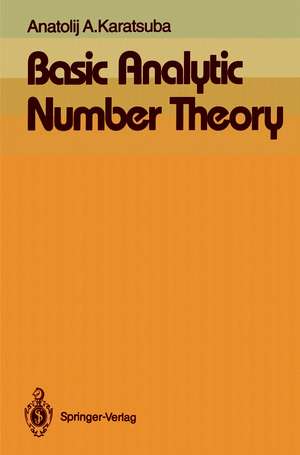Basic Analytic Number Theory
Autor Anatolij A. Karatsuba Traducere de M.B. Nathansonen Limba Engleză Paperback – 14 oct 2012
Preț: 525.89 lei
Preț vechi: 618.69 lei
-15% Nou
Puncte Express: 789
Preț estimativ în valută:
100.64€ • 103.97$ • 83.76£
100.64€ • 103.97$ • 83.76£
Carte tipărită la comandă
Livrare economică 25 martie-08 aprilie
Preluare comenzi: 021 569.72.76
Specificații
ISBN-13: 9783642634369
ISBN-10: 3642634362
Pagini: 240
Ilustrații: XIII, 222 p.
Dimensiuni: 155 x 235 x 13 mm
Greutate: 0.37 kg
Ediția:Softcover reprint of the original 1st ed. 1993
Editura: Springer Berlin, Heidelberg
Colecția Springer
Locul publicării:Berlin, Heidelberg, Germany
ISBN-10: 3642634362
Pagini: 240
Ilustrații: XIII, 222 p.
Dimensiuni: 155 x 235 x 13 mm
Greutate: 0.37 kg
Ediția:Softcover reprint of the original 1st ed. 1993
Editura: Springer Berlin, Heidelberg
Colecția Springer
Locul publicării:Berlin, Heidelberg, Germany
Public țintă
ResearchCuprins
I. Integer Points.- §1. Statement of the Problem, Auxiliary Remarks, and the Simplest Results.- §2. The Connection Between Problems in the Theory of Integer Points and Trigonometric Sums.- §3. Theorems on Trigonometric Sums.- §4. Integer Points in a Circle and Under a Hyperbola.- Exercises.- II. Entire Functions of Finite Order.- §1. Infinite Products. Weierstrass’s Formula.- §2. Entire Functions of Finite Order.- Exercises.- III. The Euler Gamma Function.- §1. Definition and Simplest Properties.- §2. Stirling’s Formula.- §3. The Euler Beta Function and Dirichlet’s Integral.- Exercises.- IV. The Riemann Zeta Function.- §1. Definition and Simplest Properties.- §2. Simplest Theorems on the Zeros.- §3. Approximation by a Finite Sum.- Exercises.- V. The Connection Between the Sum of the Coefficients of a Dirichlet Series and the Function Defined by this Series.- §1. A General Theorem.- §2. The Prime Number Theorem.- §3. Representation of the Chebyshev Functions as Sums Over the Zeros of the Zeta Function.- Exercises.- VI. The Method of I.M. Vinogradov in the Theory of the Zeta Function.- §1. Theorem on the Mean Value of the Modulus of a Trigonometric Sum.- §2. Estimate of a Zeta Sum.- §3. Estimate for the Zeta Function Close to the Line ? = 1.- §4. A Function-Theoretic Lemma.- §5. A New Boundary for the Zeros of the Zeta Function.- §6. A New Remainder Term in the Prime Number Theorem.- Exercises.- VII. The Density of the Zeros of the Zeta Function and the Problem of the Distribution of Prime Numbers in Short Intervals.- §1. The Simplest Density Theorem.- §2. Prime Numbers in Short Intervals.- Exercises.- VIII. Dirichlet L-Functions.- §1. Characters and their Properties.- §2. Definition of L-Functions and their Simplest Properties.- §3. TheFunctional Equation.- §4. Non-trivial Zeros; Expansion of the Logarithmic Derivative as a Series in the Zeros.- §5. Simplest Theorems on the Zeros.- Exercises.- IX. Prime Numbers in Arithmetic Progressions.- §1. An Explicit Formula.- §2. Theorems on the Boundary of the Zeros.- §3. The Prime Number Theorem for Arithmetic Progressions.- Exercises.- X. The Goldbach Conjecture.- §1. Auxiliary Statements.- §2. The Circle Method for Goldbach’s Problem.- §3. Linear Trigonometric Sums with Prime Numbers.- §4. An Effective Theorem.- Exercises.- XI. Waring’s Problem.- §1. The Circle Method for Waring’s Problem.- §2. An Estimate for Weyl Sums and the Asymptotic Formula for Waring’s Problem.- §3. An Estimate for G(n).- Exercises.- Hints for the Solution of the Exercises.- Table of Prime Numbers < 4070 and their Smallest Primitive Roots.



















